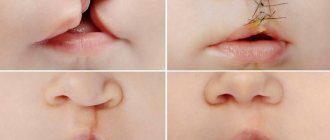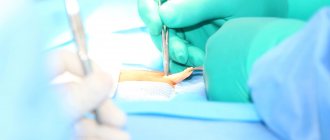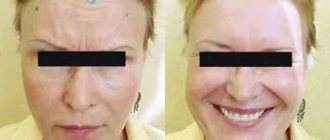Home|Facial malformations (cleft lip and palate)|Cleft palate (cleft palate)
Congenital defect of the hard and soft palate (cleft palate pathology) is a common facial malformation in infants. About a hundred babies are born every day in the world with this anomaly, most of whom are boys. It manifests itself as a rupture in the middle part connecting the oral cavity with the nasal cavity. Half of the children with this defect have a cleft lip defect. With timely treatment, cracks in the palate of a child are not dangerous to the life and health of the baby. The Towards Life project allows you to receive qualified medical assistance in correcting such defects free of charge.
Causes of cleft palate formation in humans
Experts do not have a consensus on the question of why children are born with a cleft palate. The appearance of the defect is associated with the presence of one or more provoking factors:
- inferiority of the germ cells of the parents: age over 40 years, hereditary gene mutations;
- infections and chronic diseases of the mother: rubella, chicken pox, herpes, syphilis, chlamydia, etc.;
- chemical intoxication: alcohol, drugs, smoking, chemicals, etc.;
- physical impact: amniotic fluid pressure, body overheating, radiation, falls, blows to the stomach, etc.
Often the cause of cleft palate is a metabolic disorder in the early stages of pregnancy, when it is accompanied by a lack of vitamins and minerals, toxicosis, lack of oxygen, and the threat of miscarriage. Taking antibiotics, sleeping pills and sedatives, medications for thyroid diseases, tumors, and arthritis can provoke a cleft palate in newborns. Psychological factors increase the risk of developing a defect: stress, prolonged experiences, lack of rest.
Types and manifestations of anomalies
The defect in newborns is manifested by a complete cleft of the soft and hard palate, passing through, or a small crack only in the soft tissues. According to the degree of bifurcation, the defect is classified into:
- complete – with splitting of soft and hard tissues up to the incisive foramen;
- incomplete - with a cleft only in the soft palate or with partial cleft of the hard palate;
- through – one- or two-sided clefts of the hard and soft palate with the inclusion of the alveolar process;
- hidden - the gap cuts only the muscles while preserving the oral mucosa.
“Cleft palate” in newborns, in addition to a cosmetic defect, is accompanied by a number of symptoms indicating disorders of the vital functions of the body. From the moment the baby is born, disturbances in sucking and swallowing of food appear. Shallow breathing develops, leading to oxygen deficiency and a tendency to inflammation of the middle ear, which negatively affects hearing. With the active growth of the baby, disorders of the speech apparatus (pronunciation of sounds through the nose) and delayed development of all body structures are detected.
Diagnosis of the defect
The intrauterine development of the fetal facial bones suggests their fusion at the 7-8th week of pregnancy. The formation of the oral and nasal cavities occurs in parallel. Disruption of these processes can become a turning point in normal development, causing abnormalities, and the cause of cleft palate in children. By 2 months, the embryo’s upper jaw is finally formed from halves growing towards each other. A delay in their fusion leads to a defect that is diagnosed in the womb.
A routine ultrasound examination reveals the defect at 14-16 weeks of pregnancy. The volume, shape of the lesion and the complexity of the disease can only be assessed after the baby is born. The diagnosis of “cleft palate” in a newborn child is clarified by examination of the pharynx and a number of additional studies. Their goal is to determine possible pathologies of skull development, breathing disorders, smell, hearing and sound production.
Our patients
Milan
| BEFORE AFTER | Diagnosis: rhinocheiloplasty Attending doctor: Bessonov Sergey Nikolaevich |
Vasilina
| BEFORE AFTER | Diagnosis: rhinocheiloplasty, uranoplasty Attending doctor: Bessonov Sergey Nikolaevich |
What should parents of a child with such an anomaly do?
The main thing is not to panic at the thought, my child has a cleft palate, and not to try to terminate the pregnancy. You shouldn’t risk the mother’s health by postponing the birth of a baby because of a defect that can be successfully treated with modern surgery. Abortion is too high a price, especially if the cause of the defect is hereditary, and it may appear during the next pregnancy. Timely surgical treatment of congenital cleft palate makes this anomaly safe for the life and health of children.
It is important to seek qualified medical help from specialists in time to correct the defect and prevent the development of numerous complications, including:
- respiratory failure leading to hypoxia (lack of oxygen);
- frequent infectious and colds that weaken the immune system;
- speech and hearing disorders;
- delayed growth and development of the jaw.
How and where to treat a cleft palate?
Cleft palate surgery and cosmetic facial plastic surgery can eliminate external defects and restore the functionality of the oral and nasal cavities in a newborn (questionable, the operation is performed at the age of two years).
During the surgical operation, the palatine and pharyngeal muscles are connected in the correct position, the integrity, normal shape and functioning of all structures are restored. The extent of surgical interventions and the appropriate age for this are determined by the type of anomaly and the complexity of the case. After a thorough examination of the baby by the surgeon, one of the treatment tactics for children with cleft palate is selected:
- Uranoplasty (corrective surgery) from the age of 2 years – for incomplete clefts in children with regular upper jaw dentition.
- Uranoplasty at 4-6 years of age with preoperative orthodontic therapy - with a narrowed upper jaw and clefting, including the alveolar process.
- Two-stage correction (soft tissue plastic surgery with narrowing of the pharynx and, 6-8 months later, surgery on the hard palate with the alveolar process with simultaneous bone grafting).
Cleft lip and palate: the defect can be corrected
Cleft lip and palate is one of the most common congenital malformations of the upper jaw: it occurs in a third of patients with congenital malformations. In Moscow, 1 in 800 babies are born with this developmental defect.
The anomaly is usually detected by ultrasound in the 1st-2nd trimester of pregnancy. Such news is a huge stress for future parents. But in most cases, thanks to timely and qualified treatment, cosmetic and functional defects in the baby can be eliminated.
At what age is surgical treatment most effective and how a complex anomaly is treated, Elvira Sergeevna Mkrtumyan, a maxillofacial surgeon and plastic surgeon at the Morozov Children's Hospital, told.
What influences the formation of a defect?
The defect is formed in the first two months of the child’s intrauterine development, when the formation of the facial skeleton occurs. The cause of the development of pathology is a chromosome abnormality.
The development of the defect is influenced by both hereditary factors (7%) and external factors (40%). External ones include infectious and viral diseases, smoking, drugs, alcoholism, the use of certain medications, lack of vitamin folic acid, poor ecology, and so on.
What types of clefts are there?
Clefts can occur in both the lips and palate. They, in turn, can be isolated (only the lips or only the palate) and through, when the defect extends to the upper lip, alviolar process and palate. Each type has varying degrees of severity. In addition, the defect can be either unilateral (usually on the left) or bilateral.
With an isolated cleft lip, as a rule, the deformation may be minor, or may be accompanied by deformation of the nasal septum, alar cartilage and alveolar cleft, which subsequently leads to dental problems.
With cleft palates (from minor clefts of the soft palate only to severe bilateral lesions of the soft and hard palates), children may have problems with eating, breathing, sucking, and subsequently with sound pronunciation. Thanks to timely surgical intervention, it is possible to obtain an ideal treatment result.
The most severe form is bilateral through cleft lip and palate. But even in this case, timely treatment and rehabilitation give the baby a chance for recovery.
If, during intrauterine diagnostics, a cleft is discovered in the baby, what should parents do?
The most important thing I would like to say to parents who are faced with this problem is that there is no need to worry. It is important to immediately consult with maxillofacial surgeons involved in the treatment of pathology.
We advise future parents even before the baby is born. We tell you how to feed your child correctly - it is better with a spoon or a bottle with special nipples in order to preserve swallowing reflexes, because with prolonged tube feeding they can fade.
Often this defect can be accompanied by pathology of the bone and cardiovascular systems, kidneys. Therefore, it is important to undergo tests immediately after birth to rule out these diseases. If the baby does not have other serious concomitant diseases, we prescribe planned surgical treatment to eliminate the defect.
At the request of the parents, after the maternity hospital, the child can be transferred to the neonatology department of our hospital, where the mother will be taught how to feed the child, examined and given recommendations for management before a planned operation.
At what age is surgical treatment most effective?
The optimal age for surgery to correct a cleft lip and eliminate nasal deformity, if there is no gross pathology among other systems, is 3 months. Earlier plastic surgeries do not provide the opportunity to obtain the best aesthetic result.
If the child has a severe form of cleft, correction can be carried out in two stages. At six months, if it concerns the palate, it is the soft palate; from one to two years, it is the hard palate. If surgical treatment is carried out in one stage, then it is performed at the age of 9 months to 1.5 years. This has a number of advantages: the child endures one rather than two anesthesia, the tissues are more mature, which means the treatment result will be more effective. We recommend palate plastic surgery for children under two years of age, until the child’s brain—the center of speech—has formed incorrect speech.
If the child has a severe form of cleft, correction can be carried out in two stages. At six months, if it concerns the palate, it is the soft palate; from one to two years, it is the hard palate. If surgical treatment is carried out in one stage, then it is performed at the age of 9 months to 1.5 years. This has a number of advantages: the child endures one rather than two anesthesia, the tissues are more mature, which means the treatment result will be more effective. We recommend palate plastic surgery for children under two years of age, until the child’s brain—the center of speech—has formed incorrect speech.
What operations are performed for cleft lip and palate?
Correction of a congenital anomaly requires an integrated approach. It is aimed not only at eliminating a cosmetic defect, but also at reconstructing functional disorders, eliminating problems with swallowing, breathing and sound pronunciation. The volume and type of operational benefit depends on the characteristics of each child and is selected individually.
If the cleft looks like an isolated lip or palate, surgical treatment will be performed in one stage. In the most difficult cases, correction is carried out in several stages.
For isolated cleft lip without significant deformation of the nose, cheiloplasty is performed. The vestibule of the oral cavity (the space located under the upper lip) is created, the integrity of the orbicularis muscle of the upper lip is restored, and a red border is formed. If the upper lip defect is more severe, then a one-stage cheilorhinoplasty (lip and nose surgery) is performed. We perform lip plastic surgery and place the alar cartilages of the nose in a symmetrical position. On the 7th day, postoperative sutures are removed and the children are discharged from the hospital with recommendations for further management of the child.
An isolated cleft palate manifests itself as an anatomical damage to the soft palate (mobile palate) or the soft and hard palate. The pathology is accompanied by impaired swallowing, breathing and sound pronunciation. Palate plastic surgery involves restoration of the hard palate and soft tissues of the velum, and closure of the alveolar process. After the operation, when children reach 3 years of age, classes with a speech therapist are recommended to prevent speech disorders, manifested by nasality and unintelligibility of speech.
If speech disorders are not eliminated through the efforts of speech therapists alone, then there is a surgical correction - elimination of velopharyngeal insufficiency. The operation involves transplanting flaps on a pedicle in the area of the pharyngeal ring.
From the age of 5, a child is sent for treatment to an orthodontist to eliminate defects in the dentofacial system. At the end of orthodontic treatment, the next stage of surgical treatment is performed - bone grafting of the alveolar cleft to eliminate the bone defect of the alveolar process.
The Morozov Children's Hospital has accumulated extensive experience in the effective treatment of cleft lip and palate. Every year, doctors perform up to 200 operations to correct these congenital malformations.
Stages of uranoplasty
Before surgery, your baby needs to learn how to feed from a spoon. Sucking after surgery for a cleft soft and hard palate in a child causes pain, impairs wound healing and scar formation. The correction is performed under general anesthesia due to the proximity of the airways and the need for complete immobility of the patient. If it is impossible to close the gap with local tissues, plastic surgery is performed with flaps taken from the cheeks or tongue. Repeated surgical interventions are possible no earlier than six months later, necessary to restore tissue and blood supply.
The operation for cleft of the hard and soft palate is carried out in several stages:
- The peeling away of plastic material on both sides of a gap to close the hole.
- Lengthening of soft tissues by cutting off the mucous membrane of the nasal cavity.
- Stitching the gap at the midline.
- Reducing the pharynx in the middle section by moving its lateral tissues to the middle.
- Step-by-step suturing (first on the nasal mucosa, then on the muscle tissue and oral mucosa) with treatment with an antiseptic solution.
- Attaching a plate that protects against infection.
Features of caring for a baby with facial clefts
Carefully clean the nose using damp cotton swabs soaked in oil (sterile olive, sea buckthorn) or herbal infusions (chamomile).
With cleft lips and palate, part of the oral mucosa is in constant contact with air. This leads to the formation of cracks and crusts on the mucous membrane of the upper lip. Toilet your upper lip, especially in the cleft area: carefully remove pre-soaked crusts and treat the surface with sterile oil.
When walking in the cold season, use gauze masks on the area of the wide cleft of the upper lip to warm the incoming air.
Rehabilitation period
The duration of postoperative rehabilitation is determined by the complexity of the case and the age of the patient.
If your child was born with a cleft palate, be prepared for the fact that his treatment will not be limited to surgery. The restoration of many functions depends on the quality of rehabilitation measures. In a hospital setting, they are aimed at improving the patient’s well-being, organizing proper nutrition, preventing disorders of the upper respiratory tract, and preventing infectious diseases and complications. In the future, the baby needs:
- additional treatment by an orthodontist for the correct relationship between the sizes of the dental arches and the development of the upper jaw;
- systematic observation by an otolaryngologist to monitor communication of the oral and nasal cavities, the functioning of the respiratory and hearing organs, and the prevention of ENT diseases;
- classes with a speech therapist to establish proper breathing, sound production, articulation, and correction of speech defects;
- consultation with a defectologist to identify possible developmental delays.
The operation is over. What's next?
The baby is prescribed treatment aimed at preventing the occurrence of rough postoperative scars of the upper lip. Scars worsen the aesthetics of the face, limit the mobility of the upper lip, which causes impaired articulation and deformation of the dentition. Physical therapy will help prevent such scars.
If the cleft lip is deep and extends into the nasal cavity, then during the postoperative period the child should wear a “nasal liner” (endonasal retainer). This is a device that creates the correct shape of the child’s nostril on the side of the cleft. The retainer is a conical tube formed along the outer edge, in the shape of a healthy nostril. The retainer is made by the orthodontist before surgery.
Children with congenital clefts need regular examinations by an otolaryngologist because they are three to four times more susceptible to ENT diseases due to abnormal communication between the mouth and nasal cavity.
Regular visits to the dentist will ensure timely sanitation of the mouth. This is an important condition for successful rehabilitation.
An important stage in the rehabilitation of a child with a cleft is sessions with a speech therapist.
Olga Legostaeva, speech therapist at the Rehabilitation Center for Speech Development at the Institute of Congenital Diseases of the Maxillofacial Region, Professor Gonchakov, explains exactly what kind of help speech therapists can provide:
“90% of children with facial clefts need speech therapy help. Sometimes such children are diagnosed with “rhinophonia” - the so-called “nasality”, the pronunciation of sounds “in the nose”. Sometimes - “rhinolalia” (voice disturbance, nasalization plus specific pharyngeal pronunciation, some sounds are replaced by exhalation through the nose, speech becomes completely incomprehensible). Sometimes, if a cleft is one of the signs in the structure of a particular syndrome (Pierre Robin syndrome, etc.), delayed speech development is possible. But even in this case, the prognosis can be favorable.
An important point is that working with those children who had facial clefts differs from working with other disorders. Often children come to us whose parents complain: “We have been working with the child for two or three years, no results. - What are you doing? - Speech therapy massage. But in this case it is not necessary to do a massage. If the child is not breathing properly, the massage will be of no use.
The most effective in this case are breathing exercises and exercises for the formation of the velopharyngeal ring.
Breathing exercises are needed to teach your child to breathe using the diaphragm and abdominal muscles. Our children with clefts usually use their collarbones and shoulders to breathe. If you teach a child to use the abdominal muscles, take a deep breath through the nose and exhale strongly through the mouth, and open the mouth correctly, correct breathing will be formed. Then it will be easy to put sounds.
The second set of exercises is necessary in order to develop the muscles of the velopharyngeal ring. Due to physiology, our children cannot close their throats, so when they phonate, the air goes into their nose. But such simple exercises as coughing, yawning, swallowing liquid in small portions, arranged in a certain system, help develop the velopharyngeal ring and create the conditions for good sound. Vocal phonopedia perfectly develops the palate.
This work is not quick, it is long, painstaking work that requires the constant participation of parents. Parents are always present at our classes; they not only write down the lessons in a notebook, but also learn how to correctly present tasks to the child and ensure that he completes them correctly.
You should start classes as early as possible. We don’t have the concept of “started studying too early.” If a child does not speak after surgery at two to two and a half years old, this is a reason to see a speech therapist. If he is three years old and speaks “in his nose,” this is also a reason to see a speech therapist.
In my experience, three-year-olds are much easier to deal with than five-year-olds. Five-year-olds have quite a long speaking experience. And in order to correct their speech defects, they have to be “broken.” Three year olds are more flexible. Therefore, I recommend starting to practice as early as possible. Usually, if we start teaching a child at three years old, by the age of five or six he no longer has problems with pronunciation. At an early age, many speech problems can be corrected.
It is only important to understand that the rehabilitation of children with facial clefts must be comprehensive. A facial cleft is not only an anatomical defect, it is a defect that impairs breathing, hearing, and speech. Therefore, when working with such children, a speech therapist alone is not enough. In our center, for example, there is a team that includes a speech therapist, a phonologist and a psychologist.”
A phonopedist is a speech pathologist who restores physiologically correct sound production.
Natalya Borisovna Silkina is a phonopedist; for three years she worked at the Rehabilitation Center for Speech Development at the Institute of Congenital Diseases of the Maxillofacial Region, Professor Gonchakov.
“90% of children with facial clefts hear worse than ordinary children,” says Natalya Borisovna. — Their hearing loss occurs due to the fact that they do not hear all frequencies. This defect can be eliminated with the help of exercises to develop phonemic hearing (starting from two years), and with the help of vocals.
It is best if the mother sings with the baby. Always. At trainings, we teach mothers to sing continuously, almost around the clock. Only in this case do the kids begin to sing on their own. The fact is that such children are not able to perceive those songs that sound from electronic media. The speed is too high. For them it is background, noise.
Moreover, it is better to talk to them slowly and loudly, pronouncing the words clearly: they will not hear enough. Therefore, when I practice with them in the center, I pronounce everything and sing it five times slower.
Older children can be taken to a vocal studio. Vocal exercises stretch tissues and relax the apparatus. The palate is the same muscle, only its sensitivity is reduced due to the suture. Vocal exercises allow you to gently work this muscle. But ideally, vocals should be studied with a phonopedist who knows the features of rhinolalia and rhinophony.”
Help from the project “Towards Life”
The scope of rehabilitation activities, the number of doctors involved in the treatment, and the cost of cleft palate surgery in well-known medical centers should not diminish your determination to improve your child’s health. After consultation with specialists, you can do a significant part of the work to restore functions (breathing exercises, exercises to develop the speech apparatus, preventive measures, etc.) with your baby yourself at home. Your persistence and patience are an important component of success in treatment.
There is also an answer to the question of where surgery for congenital cleft palate is performed free of charge - in Yaroslavl. With the support of charitable organizations (Rusfond, “Beautiful Children in a Beautiful World”), we offer medical care from the best specialists without payment. To receive free surgical treatment from our maxillofacial surgeons: Doctor of Medical Sciences, Professor S.N. Bessonova and L.A. Eremeyshvili, you need to collect the necessary documents according to the list, send them for consideration and wait for the call for treatment.
You can make an appointment with a specialist by phone: 8 on weekdays from 9.00 to 19.00 Moscow time Or through the form on the website Sign up for a free consultation
Cleft lip and cleft palate are not for life!
Let’s make a reservation right away: do not confuse maxillofacial surgery (maxillofacial surgery) with plastic surgery in its pure form.
Of course, they are inextricably linked and complement each other, but the goals and objectives of maxillofacial surgeons are different. One of the main ones is early correction of congenital cleft lip and palate in its various combinations. Simply put, this anatomical defect, due to its similarity with the structure of the corresponding organs in a hare and a wolf, is rigidly referred to in everyday life as “cleft lip” and “cleft palate.” In modern world medicine it is called cleft lip and palate. According to statistics, cleft lip and cleft palate account for the lion's share of all existing congenital facial defects, namely, according to WHO, this is 1 case in 700 newborns; in Russia, up to 2,600 babies are born with cleft lip and palate every year. Children with a similar defect from birth require increased care: special nipples should be used for feeding them and more carefully protected from external infections, since due to a violation of the anatomical structure they are more susceptible to any ARVI.
It happens that the defect in a cleft lip is insignificant and consists of a small pit or groove on the upper lip. However, most often, a cleft lip in newborns looks like a 1-2 cm or longer through defect in the upper lip, the end of the nose, widely communicating with the oral cavity. A cleft palate is a pronounced anatomical defect of its anterior part (hard palate) and/or soft palate (movable velum) with impaired breathing, swallowing and speech.
The defect will definitely become a traumatic factor for the child as soon as he grows up and realizes that he is different from his peers. The child’s parents should know that timely treatment and rehabilitation will help avoid these problems. The disease does not affect the child’s mental abilities in any way!
Today, thanks to the increased modern capabilities of medicine, children with cleft lip and palate have a real chance not only to live, but to live a quality life and successfully socialize in society.
What is the optimal time for correction of cleft lip and palate in children?
Our hospital specialists can answer this question briefly: the sooner the better. With one caveat: everything is decided individually for each child. This is a principled position with fundamental scientific justification.
Our interaction with a potential patient begins before he is born. Oral and maxillofacial surgeons are approached at the stage of intrauterine diagnosis of cleft lip and palate: at 18–20 weeks of pregnancy according to ultrasound results. If the presence of this malformation is confirmed, we explain to the mother that she has the opportunity to enter the Moscow maternity hospital, give birth safely under the supervision of specialists, and then, in the absence of any other severe pathology, in the first days of life the child will be admitted to our neonatal department. Here, after the necessary preparation, he will undergo reconstructive surgery to repair a cleft lip or palate.
Early correction is aimed at ensuring that the baby can quickly switch to natural breastfeeding, begin to fully suck, swallow, breathe, and subsequently talk. In our experience, the sooner treatment and rehabilitation are carried out, the faster all these vital functions are restored, and the child will be more successfully socialized in the future.
Yuri Olegovich Volkov
maxillofacial surgeon, candidate of medical sciences, head of the department of maxillofacial surgery of the Children's City Clinical Hospital named after. G.N. Speransky in Moscow








